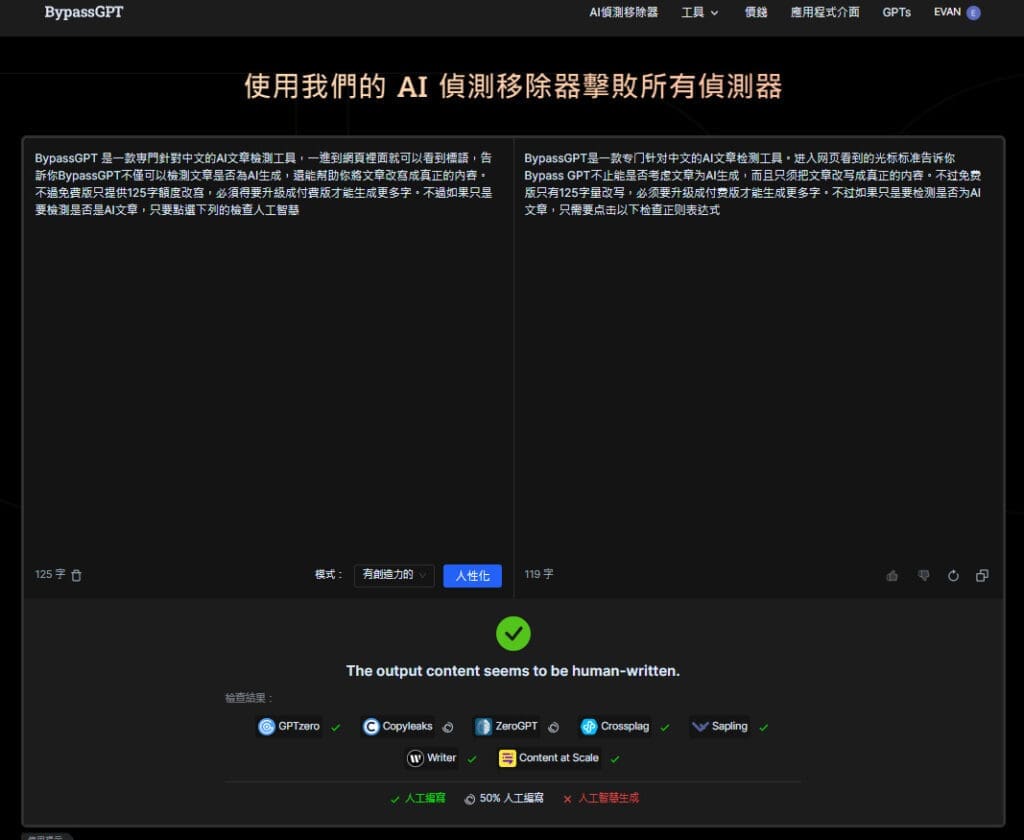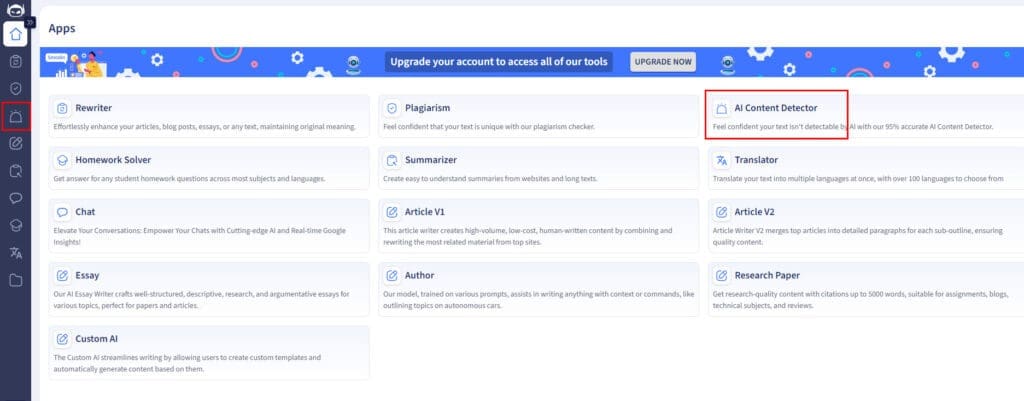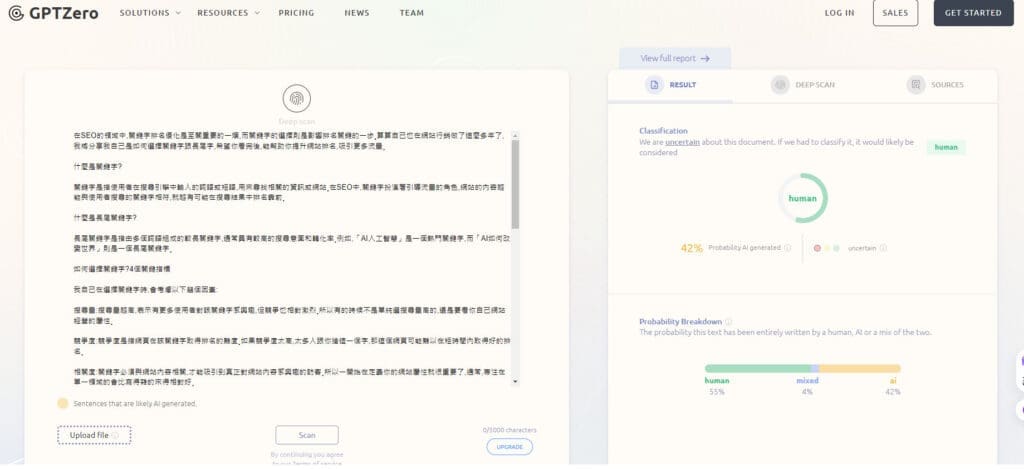In the realm of SEO, originality is a crucial factor. To ensure the uniqueness of website content, many rely on tools like ChatGPT to expedite their writing. However, excessive use of AI-generated content can be problematic. Following Google’s December core update, many websites utilizing AI saw a sharp decline in traffic. So, how can you avoid having your articles flagged as AI-generated and humanize your content? This guide is indispensable!
What Are AI Content Detection Tools?
AI content detection tools use artificial intelligence to analyze and evaluate the quality of a piece of writing. Essentially, these tools leverage AI to detect AI. By employing machine learning techniques, they differentiate between human-written and AI-generated content. These tools provide scores, suggestions, and feedback to help improve the quality and SEO performance of your articles.
Featured AI Detection Tools
BypassGPT:
BypassGPT is an AI content detection tool specifically designed for Chinese. Its interface prominently advertises its ability to not only detect AI-generated text but also rewrite it to make it appear more human. The free version allows checking only 125 characters at a time, while the paid version offers extended features. BypassGPT also integrates seven free AI detection tools, including GPTZero, Copyleak, ZeroGPT, Crossplag, Sapling, Writer, and Content at Scale, allowing users to compare multiple platforms’ assessments simultaneously. However, since not all tools support Chinese, some results should be taken with a grain of salt.

Copyleaks

Copyleaks stands out for its unlimited character count in its free online scanning service. This is in contrast to other tools that often cap free usage at 100-150 words with limited attempts. Copyleaks demonstrates high accuracy, particularly in identifying fully AI-generated content. However, its accuracy decreases when detecting mixed content (human + AI).
Notably, Copyleaks introduced an “AI Insights” feature that provides a comprehensive analysis of why a piece of text is flagged as AI-generated and offers actionable suggestions for improvement. This feature is particularly helpful for making precise adjustments to enhance the human quality of content.

MitataAI

MitataAI, developed for the Chinese market, offers tools tailored to the language. Users can test up to 10,000 Chinese characters with 10 free daily attempts. MitataAI provides user-friendly options for rewriting content to reduce AI detectability, making it one of the most Chinese-friendly tools.
Smodin:

Smodin is a free AI detection tool supporting multiple languages, including Simplified Chinese. It offers 5,000 free characters, sufficient for most users. However, it occasionally misclassifies human-written content as AI-generated. For SEO purposes, keeping the AI content ratio low is generally acceptable.
Monica:

Monica integrates three free AI detectors—GPTZero, Copyleaks, and ZeroGPT—within its Chinese AI writing tool. Although it doesn’t offer free usage, its simple interface ensures ease of operation.
AI Undetect:
AI Undetect features a traditional Chinese interface but uses Simplified Chinese for detection. It combines six AI detection tools, including GPTZero, Copyleaks, and Sapling, providing accurate analyses. However, due to its free nature, users may occasionally encounter system overload issues.

GPTZero:
GPTZero, a widely referenced AI detection tool, is entirely free and provides detailed analyses of AI vs. human writing ratios. However, its strict criteria often result in higher AI classifications than expected.

ZeroGPT
Once touted as ChatGPT’s nemesis, ZeroGPT offers a free allowance of 15,000 characters. Its performance in English detection remains top-notch, but its interface is cluttered with ads, and it lacks support for Chinese.

Humbot

Originally, HumBOT, like other AI content detection tools, offered accurate identification of whether content was AI-generated, even catching minor edits. However, the focus has shifted beyond merely providing detection percentages. Users now seek ways to make their writing less identifiable as AI-generated. In response, HumBOT introduced a humanization feature designed to bypass AI detectors like Originality.ai, GPTZero, and Turnitin. Developed by in-house professionals, this AI tool can identify AI-written content and then rewrite it to infuse a more human touch.
Here’s an example for reference:
ChatGPT
When planning travels, start by setting a budget and researching your destination to make the most of your time and money. Create a flexible itinerary, allowing for unexpected detours. Pack light, but don’t forget essentials like a first aid kit. Embrace local culture, try authentic cuisine, and connect with locals for a more immersive experience. Lastly, don’t forget to document your journey through photos and journaling to cherish the memories later.
ChatGPT-4o
When planning travels, research destination specifics, such as weather, customs, and local attractions. Book flights and accommodations in advance to secure deals. Use a detailed itinerary to organize activities, but allow flexibility for spontaneous exploration. Always pack essentials and remember travel insurance for unexpected situations. Happy and safe travels!
Humbot
When you’re planning travels, know things like places of interest, weather, and cultural norms of your destination. Book your airline tickets and hotel rooms in advance as it’s more likely to get special offers or discounts. Plan a detailed schedule and route so you can keep everything organized, but allow time for exploring places that are unplanned. Only put what you need in your luggage, and buy travel insurance for unexpected situations. Hope you have a wonderful and safe journey!
It’s clear that after applying humanized rewriting, the sentences appear less rigid and flow with a better rhythm, making the text more engaging and natural to read.
unDetectable AI

unDetectable AI stands out from other detectors with its generous character limit, allowing up to 15,000 characters per use—equivalent to approximately 7,500 Chinese characters! Unlike many tools with restrictive limits, this one supports Simplified Chinese, making it especially valuable for users needing AI content detection in Chinese. No longer do users have to translate back and forth between English and Chinese for accurate detection. It’s no surprise that Forbes named it the top AI content detection tool.
Ironically, however, when testing with its own “humanized” writing samples, the tool flagged them as AI-generated. XD

However, a section I personally wrote did successfully pass the detection test

AI Undetect

AI Undetect, which shares a similar name with unDetectable AI, integrates several leading AI detection interfaces, including GPTZero, CopyLeak, Writer, Winston AI Detector, Turnitin, and Originality AI. This allows users to test their content across multiple platforms simultaneously to verify whether it passes detection.
If your content is unfortunately flagged as AI-generated, the tool also provides an AI humanization rewrite feature. After optimization, the rewritten content successfully bypasses all the detectors!

AI Undetect has developed its proprietary “Undetectable AI Humanization Tool,” a large-scale model designed to enhance anti-AI detection capabilities. This tool strengthens the rewriting process, making the content align more closely with natural human writing styles.
Factors to Consider When Choosing Paid AI Content Detection Tools
When selecting a paid AI content detection tool, here are some key factors you should consider:
- Accuracy:The tool should offer high accuracy, capable of reliably identifying AI-generated text.
- Feature Diversity:An ideal tool should provide a variety of functions, such as AI text detection, text rewriting, and similarity analysis.
- User Interface:The interface should be user-friendly and intuitive, enabling users to operate the tool quickly and efficiently.
- Privacy and Security:Ensure the tool effectively safeguards user privacy and data security.
- Language Support:Since simplified Chinese is more widely used globally than traditional Chinese, AI-generated texts often employ simplified Chinese expressions. When selecting a platform, opt for one that can accurately analyze Chinese texts to better meet your needs, making it more worthwhile to invest in.
Do You Really Need to Use AI Detection Tools? Can the Human Eye Determine It?
The answer is certainly yes. As long as you master the following two tips, you can easily identify whether the article is AI-generated.
- Check the Style and Grammar of the Article:AI-generated text often has an unnatural style, with more grammar errors and fewer conversational filler words, which are commonly used in human writing.
- Verify the Source of the Article:Due to intellectual property regulations in response to AI-generated content, many countries are now setting rules and standards. Additionally, to combat fake content, governments are emphasizing the importance of verifying the authenticity of texts. For example, Google’s Gemini often includes references when generating content, helping to verify whether the information is accurate. If the source of the article is unclear, it may very well be AI-generated.
How to Correctly Use AI Detection Tools?
- Avoid Plagiarism:AI-generated text may overlap with existing content, leading to plagiarism disputes.
- Enhance Originality:Originality is a key factor in SEO. Detecting AI-written articles can help ensure the originality of website content.
- Protect Brand Image:If website content is found to be plagiarized or AI-generated, it could damage the brand image of the website.
- Comply with Laws and Regulations:In certain countries or regions, using AI-generated content might violate relevant laws and regulations.
Here are some specific examples:
- If a website’s content is found to be plagiarized or AI-generated, it may be downgraded or removed from search engines.
- If a website’s content is identified as plagiarized or AI-generated, legal action may be taken.
- If a website’s content is plagiarized or AI-generated, it could lose user trust.
Therefore, before publishing AI-generated articles, it’s important to conduct a thorough detection to ensure their originality.
Conclusion:
After trying out many AI article detection tools, some paid and some free, one thing remains clear: the purpose of detection is not just to identify whether something is AI-generated or not. It’s more about how to make your article more human-like—or rather, “human-like” in the eyes of AI. This makes sense, as AI is trained on data from texts written by humans, including common phrases and sentence structures. If these familiar expressions are widely used, AI will likely mimic them in its writing.
Therefore, most of these websites don’t primarily focus on AI detection. Instead, they charge for upgraded services that offer rewriting tools, which help make your article “more human-like” to avoid being identified as AI-written.
Overall, Google’s SEO strategy after 2024 will focus on combating AI content, especially articles that are simply copied and pasted without changes. If your content is original and based on your personal experiences, you don’t need to worry about being impacted by the 2024 March SEO rule changes.
Update (12/31/2024):
Recently, I have seen a lot of complaints on social media and X (formerly Twitter) about the significant drop in traffic following Google’s core update in December. It was a sharp and vertical decline. In reality, Google hasn’t banned AI-generated content, but it should be used as a tool to assist, not to simply copy and paste. When writing, we must be extra careful to avoid making mistakes that could cause bigger problems.



